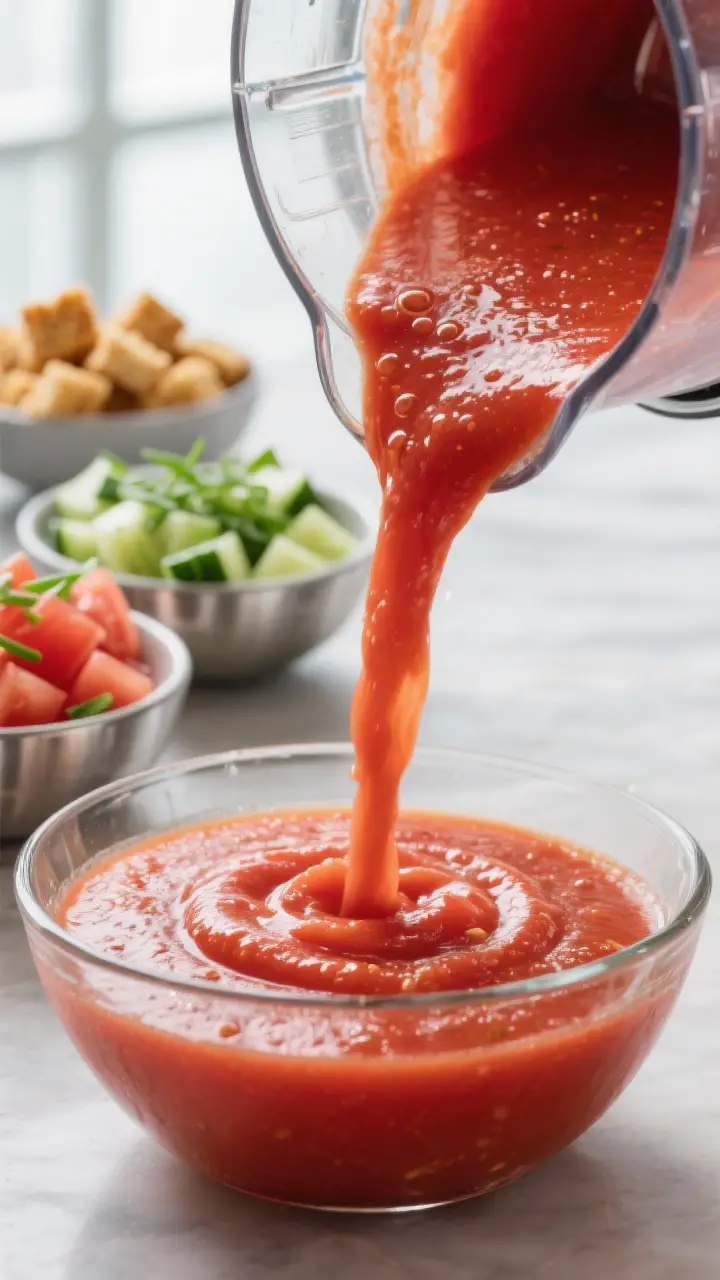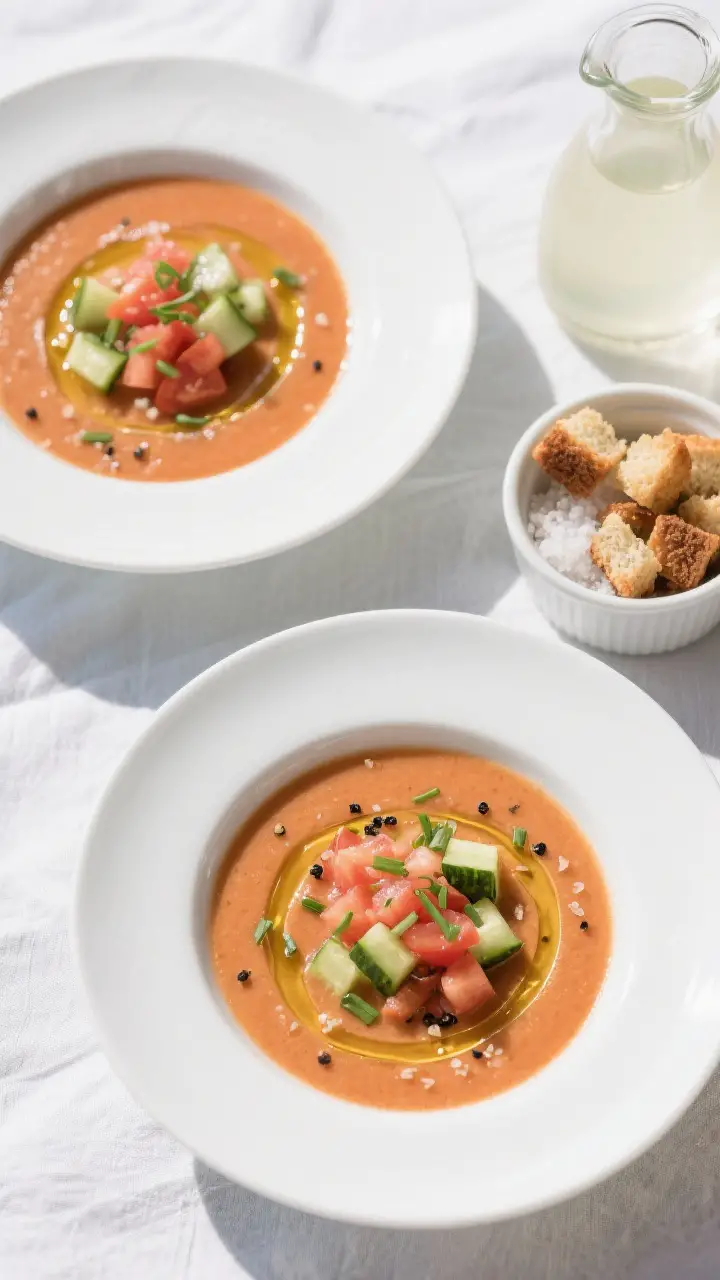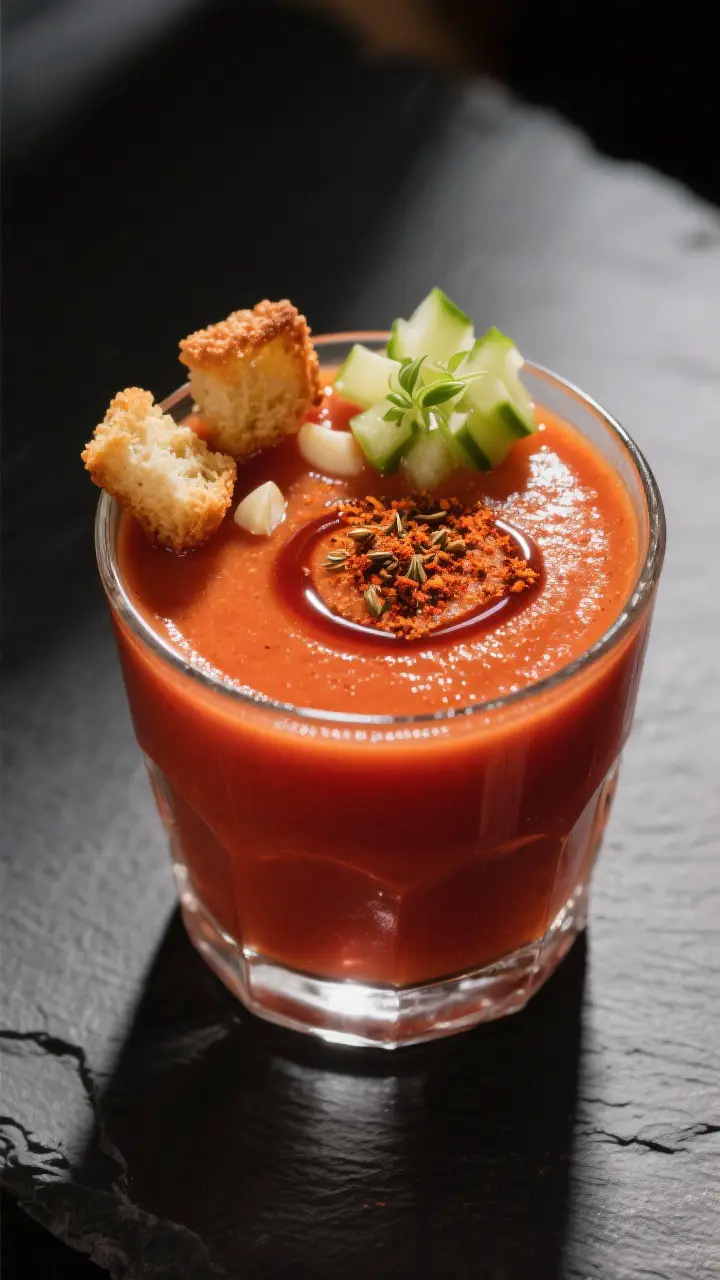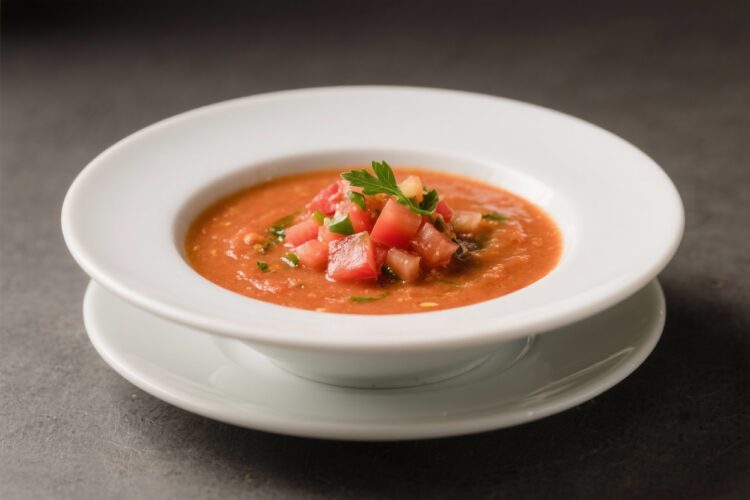You know that moment when your kitchen feels like a sauna and your motivation to cook evaporates? That’s your sign to make Refreshing Gazpacho. It’s cold, crisp, and hits harder than an ice bath—without the shock.
Five minutes of chopping, a whirl in the blender, and boom: restaurant-level flavor with zero heat. This is the kind of meal that makes you feel smugly healthy while still tasting like a vacation in Spain.
The Secret Behind This Recipe

The magic of a great gazpacho comes down to two things: tomato quality and balance. Use ripe, heavy tomatoes that smell like sunshine—Roma or vine-ripe are ideal.
Balance the sweetness with a little acidity (sherry vinegar is classic) and a touch of fat (extra-virgin olive oil) for that silky, luxurious finish. Salt matters more than you think. Season early to help the vegetables release their juices, then adjust after chilling.
And yes, chilling is non-negotiable. Gazpacho transforms in the fridge, melding into something far greater than the sum of chopped produce.
Ingredients
- 2 pounds ripe tomatoes (Roma or vine-ripe), cored and roughly chopped
- 1 English cucumber (or 2 Persian), peeled if waxed, roughly chopped
- 1 red bell pepper, seeded and chopped
- 1 small red onion, chopped
- 2 garlic cloves, minced
- 1/3 cup extra-virgin olive oil, plus more for drizzling
- 2–3 tablespoons sherry vinegar (to taste)
- 1 slice country bread (optional), crust removed, torn
- 1 teaspoon kosher salt, plus more to taste
- 1/2 teaspoon freshly ground black pepper
- 1/2 cup cold water (as needed to adjust thickness)
- Garnishes: diced cucumber, diced tomato, chopped chives, croutons, flaky salt
Cooking Instructions

- Prep like a pro: Wash and chop the tomatoes, cucumber, bell pepper, and onion into chunks the blender can handle. Reserve a small handful of diced veg for garnish if you want restaurant vibes.
- Salt to unlock flavor: In a large bowl, combine tomatoes, cucumber, pepper, onion, and garlic.
Add the kosher salt and toss. Let it sit 10–15 minutes to draw out juices and soften edges.
- Blend in stages: Add the soaked bread (if using), olive oil, sherry vinegar, and half the veggies to a high-speed blender. Blend until smooth.
Add remaining veggies and blend again. For an ultra-silky texture, run the blender a bit longer than feels reasonable.
- Adjust texture: Add cold water, a few tablespoons at a time, until it reaches a pourable, creamy consistency. Not a smoothie, not a juice—something in between.
- Season smart: Taste and add more vinegar, salt, or pepper.
If your tomatoes aren’t peak-season, a pinch of sugar can help balance acidity. No shame.
- Chill the deal: Transfer to a covered pitcher or bowl and refrigerate at least 1–2 hours. This step is where flavors marry.
Skipping it is like skipping leg day—don’t.
- Serve cold: Stir, pour into bowls, and garnish with diced cucumbers, tomatoes, chives, and a drizzle of olive oil. Add croutons or a crack of black pepper for crunch and contrast.
Preservation Guide
- Refrigerator: Store in an airtight container for up to 3 days. Stir before serving as separation is normal.
- Freezer: You can freeze for up to 2 months in sealed containers, leaving headspace.
Thaw in the fridge and reblend for texture.
- Meal prep tip: Keep garnish components separate to maintain crunch and color. Portion into jars for grab-and-go lunches.
- Avoid metallic bowls: Acidic ingredients can pick up off-flavors from reactive metals. Glass or stainless steel only.

Benefits of This Recipe
- No cooking, zero drama: Perfect for heat waves, small kitchens, or days you’d rather not babysit a stove.
- Nutritious without trying: Packed with lycopene from tomatoes, hydration from cucumbers, and fiber if you include the bread.
- Insanely versatile: Works as a starter, light lunch, or snack.
It’s elegant enough for guests and easy enough for Tuesday.
- Budget-friendly luxury: Peak-season produce + pantry staples = ridiculous flavor on the cheap, IMO.
- Make-ahead friendly: Improves after resting, which means you can “set it and forget it” like a culinary magician.
What Not to Do
- Don’t skip the chill time: Warm gazpacho is just sad tomato soup. The cold temperature is part of the experience.
- Don’t overdo the garlic: Two cloves are plenty. Raw garlic gets aggressive fast and will dominate everything.
- Don’t use bland tomatoes: Out-of-season tomatoes equal meh flavor.
Opt for high-quality canned whole tomatoes as a backup, or add roasted red peppers for depth.
- Don’t make it watery: Add water gradually. You’re aiming for smooth and drinkable, not tomato-flavored water.
- Don’t forget acid and salt: Underseasoning kills brightness. Sherry vinegar and salt are your besties here.
Variations You Can Try
- Watermelon Gazpacho: Replace half the tomatoes with seedless watermelon.
Add a squeeze of lime and mint. Sweet-salty perfection.
- Green Gazpacho: Use green tomatoes, cucumber, green bell pepper, and herbs like basil and parsley. Finish with a splash of rice vinegar.
- Spicy Andalusian: Add half a jalapeño (seeded) and a pinch of cumin.
Garnish with smoked paprika oil. FYI, it slaps.
- Protein Boost: Top with chopped shrimp, crumbled feta, or grilled halloumi. It turns into a legit meal.
- Creamy Twist: Blend in a small avocado for extra body.
Adjust vinegar to keep brightness.
- Crunch Factor: Add toasted almonds or garlicky croutons. Texture is flavor’s hype man.
FAQ
Can I make this without a blender?
Yes. Finely chop everything and mash with a mortar, pestle, or potato masher.
The texture will be rustic but still delicious, and honestly more traditional.
Is sherry vinegar mandatory?
No, but it’s ideal. Substitute with red wine vinegar or a mix of lemon juice and a splash of apple cider vinegar. Adjust to taste so it stays bright, not harsh.
What if my gazpacho is too thick?
Add cold water a tablespoon at a time until it’s smooth and sippable.
Then taste again—thinning can dilute seasoning, so re-adjust salt and vinegar.
Can I use canned tomatoes?
If fresh tomatoes are flavorless, high-quality canned whole peeled tomatoes work in a pinch. Drain lightly, then add a few cherry tomatoes or roasted peppers for freshness and complexity.
How do I fix a gazpacho that tastes flat?
Add a pinch of salt, a splash more sherry vinegar, and a drizzle of good olive oil. If tomatoes were weak, a tiny pinch of sugar can help balance acidity.
Is bread necessary?
No.
Bread adds body and creaminess, but you can skip it for a gluten-free version. A small piece of avocado can mimic the texture if you want it creamier.
How long should it chill?
At least 1–2 hours. Overnight is even better, just stir and re-season before serving because flavors mellow with time.
In Conclusion
Refreshing Gazpacho is the ultimate low-effort, high-reward recipe: cold, punchy, and wildly satisfying.
With top-notch tomatoes, the right acid, and a chill period, you’ll get a silky, vibrant bowl that tastes like summer. Customize it, meal-prep it, or dress it up for guests—this is your warm-weather cheat code. When the thermostat spikes, this is how you win lunch.
Printable Recipe Card
Want just the essential recipe details without scrolling through the article? Get our printable recipe card with just the ingredients and instructions.

